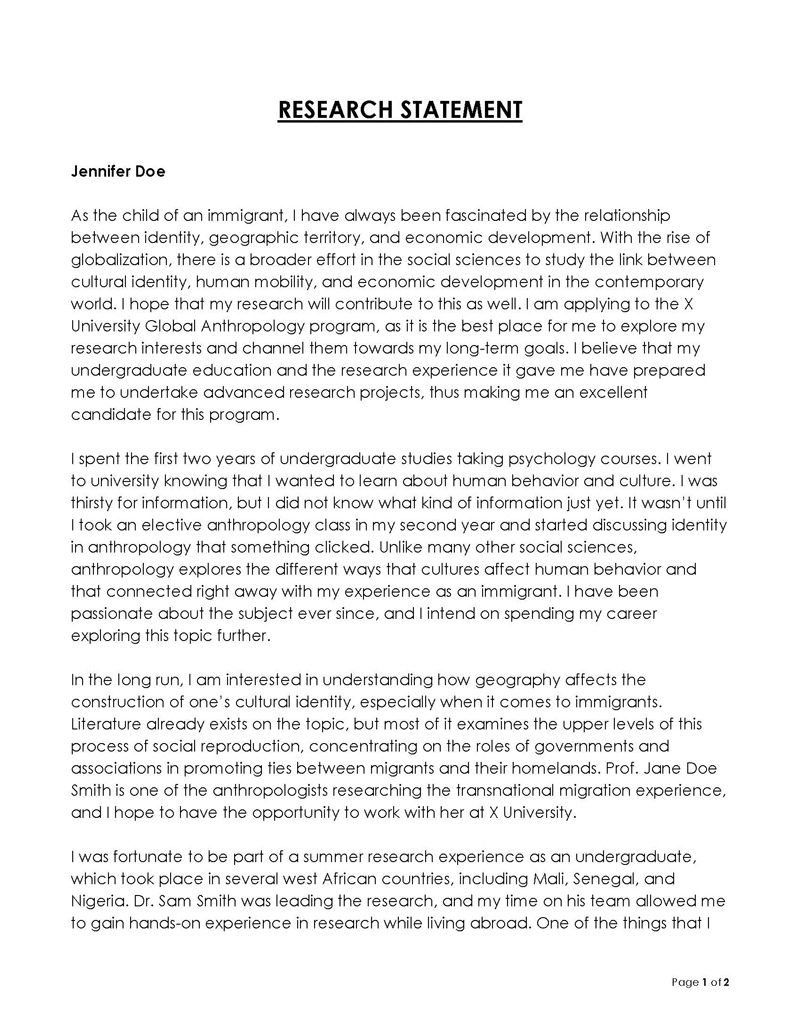When applying for a faculty position, a research statement (or summary of research interests) is a document that outlines an applicant’s experience, including interests, accomplishments, ongoing research, and future goals. The selection committee uses the document to determine if your interests and experience align with the department, institution, or program.
Research is valuable in academia. Educators and educational institutions contribute to society by researching important social, scientific, or medical issues. It is thus a vital consideration when being selected for any faculty position. Key elements of the statement include; funding history and potential collaborations; project requirements, such as laboratory equipment, facilities, etc., and the proposed direction of upcoming projects. Include a summary of the contributions made by your past and present projects to other fields, your field of study, and the profession (along with an explanation of why this is a good fit).
A strong research statement should be comprehensive, technical enough for academics in the field, but broad enough for selection committee members from other disciplines.
Some common flaws in the document include unclear direction and vagueness, overly ambitious or unrealistic proposals, a failure to focus on the big picture, and a misalignment with the faculty’s goals, needs, and facilities. Use this article to learn more about how to create a suitable research statement that improves your application for a faculty position.
Research Statement Examples



What a Good Research Statement Must Include
The statement of research interests should be detailed, ambitious, and realistic; it should present the highlights of your research journey objectively and professionally. By emphasizing previous experience, you can establish your suitability for undertaking projects. The document informs the committee of your track record and offers context regarding your interests by indicating the motivation and importance/relevance of previous studies. It also gives an overview or background of your subject, the strengths and limitations of your previous projects, and their relevance to future projects.
The document also establishes qualifications for a job position by illustrating your academic strengths and competencies, specialty, expertise, and compatibility with the faculty. It also demonstrates your ability to be innovative, think critically, and communicate as an academic or scholar.
How Your Research Statement Should Look
The statement is a formal document and should be formatted.
note
Your statement will typically be reviewed by scholars, academicians, and top administrative personnel within the faculty. The document must be written to appeal to the different categories of personnel.
You should incorporate the following formatting guidelines:
- Keep the length of the document at one or two pages (three if absolutely necessary).
- Utilize headings and subheadings to categorize information.
- Bullet points are also allowed to itemize details and points that do not require detailed explanations.
- Ensure the font and font size you use are legible and the margins are enough to ensure the contents of your document do not appear clogged up or uneven.
note
A research statement should be written in the third person (present tense) as it gives a sense of objectivity, not the first person, which can sometimes feel more personal than professional.
How to Structure a Research Statement
Your research statement demonstrates your intellectual integrity, capacity for success in an academic setting (including learning and teaching), and familiarity with the current research landscape.
To capture this information, you can follow the steps discussed below when planning what to include in the document;
Step 1: Write a summary of your research
The first step is to undertake a detailed self-assessment of your interests, field of study, achievements, and importance. The self-assessment should include reviewing past and current projects, activities, publications, and presentations. You should then summarize your research and highlight the theme guiding your studies. Mention any significant areas that you would like to contribute to, any new ideas you have, and the main conclusions of your work. This section should get the reader excited and prepare them for what to expect in the document.
Step 2: Include a brief history of your past research
Secondly, you should discuss your past work. This section, which should include specific projects you have worked on and issues you are trying to solve, should be more detailed than the summary above. It offers a sense of consistency and allows the committee to determine the progress you have made in your work. Remember to keep the content as relevant as possible.
Step 3: List major findings, outcomes, and implications
Next, you should address your achievements. This section can either list the themes, projects, topics, or areas of focus you have worked on chronologically or by specific subheadings. You can outline the guiding questions of your project, methodologies used, findings, contribution to the field of study, outcomes such as publications, presentations, essays, reports, etc., and implications such as collaborations, awards, conferences, etc.
Step 4: Discuss your current research
This section helps to highlight your interests, skill sets, and capabilities necessary for the job position. Here, you can explain why you were interested in this subject and list some of the citations on which you have based your work. This section gives you the opportunity to highlight the novelty of your work, and thus the value of your work to the field of study and how it contributes to the subject should be covered here.
You must briefly discuss the methodology you used and the findings in concrete terms. Any partnerships with third parties and any funding you may have received for your work should be highlighted here. Include professional engagements, upcoming conferences, and upcoming publications in this section as well.
Step 5: Describe your future goals or plans
Finally, you should also mention how your current and past research has prepared you for your future plans. Since you are applying for a faculty position, you should demonstrate a clear vision of your future plans. This should include information on the problem you intend to focus on, the relevance of the issues to the field of study, and your academic and professional goals for the next 3-5 years.
Also, mention how your interests and ambitions align with the department’s and institution’s needs. You can achieve this by determining the faculty’s most important needs and objectives, paying close attention to the faculty’s research profile, and choosing an appropriate study topic that most closely aligns with both their and your objectives.
Step 6: Identify potential funding sources
Most institutions will want to know about any external funding you may be able to access, and it can be an incentive for them to accept your application. Therefore, you should mention any potential funding sources at your disposal. This can be discussed by providing relevant details of sources of funds, such as grants from private institutions, government agencies, academic organizations, foundations, etc., and any other sources of funding you may have.
Important Considerations
The strength of your research statement might be the most important deciding element in your application. If it is adequate, it can help you secure the position.
Here are some things to consider when preparing your statement:
Avoid jargon
Avoid using terms and phrases that may be too technical or unclear. Make the statement understandable for people outside your discipline.
note
Note that the recruiting committee will comprise individuals from different disciplines, and if they are to review your application impartially, they need to understand what you intend to communicate.
Be realistic
Make sure you do not exaggerate your skills. Try to focus on specific projects and problems that are within your competencies. You can accomplish this by having a clearly defined theme for your statement. Exclude any minor projects, and the focus should be on the key and most significant ideas. The more reasonable your expectations are, the better off you will be. Though it is fine to have lofty plans for the future, do not assume that you can achieve them all at once.
Include examples
Provide examples of your achievements to demonstrate your skills. Focus on a few relevant successes using your own words.
EXAMPLE
Tangible examples include referencing resultant publications, presentations, professional engagements, etc.
Be confident
Make sure you write with confidence and believe in what you want to say. You should be confident in your skills, achievements, and future goals. Therefore, avoid vague statements and present yourself as a well-qualified applicant.
Proofread
Do not forget to edit your document, including all detailed references, to ensure everything is correct. Some important points to consider are proper citations and formatting (spelling, punctuation, and grammar). Be sure to read over what you have written several times and make the necessary corrections before sending it to another person for review.
Frequently Asked Questions
A research statement highlights a job applicant’s experience in research and how that makes them suitable for an academic position. This requires citing specific current, past, and future projects and mentioning specific details about the project. However, a CV emphasizes a job applicant’s educational and professional background to show that they are qualified for the positions being applied for.
Yes. You should consider creating a longer version of your research statement to take to the interview. The statement can be five to fifteen pages long. It is needed because, during the interview, you may be asked to provide in-depth details such as an activity schedule, budget, human resource requirements, and other specifics, which you can include in the longer version, unlike the standard version.
Yes. It is recommended that you mention potential eternal funding sources and previous funding. This can be any external source, from foundations to government institutions.




